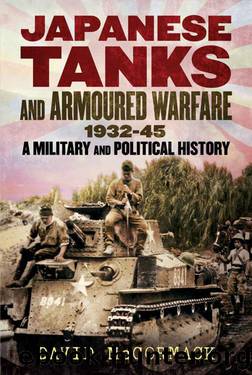Japanese Tanks and Armoured Warfare 1932-1945: A Military and Political History by David McCormack

Author:David McCormack [McCormack, David]
Language: eng
Format: epub
Publisher: Fonthill Media
Published: 2021-03-08T16:00:00+00:00
12
A Measure of Things to Come
The Integration of Tank Forces into
Evolving Japanese Island Defence Tactics
The American plan to invade Guam in June 1944 had been postponed as a consequence of the unexpectedly stubborn Japanese resistance on Saipan and the great naval showdown in the Philippine Sea. On Saipan, the Japanese garrison had conducted a skilful defence which tied up large numbers of American troops for several weeks. At sea, the story was very different as the Japanese Navy was faced with the loss of the three aircraft carriers Taiho, Shokaku, and Hiyo following a disastrous encounter which had shattered the carefully rebuilt carrier arm. The only glimmer of hope remaining lay in the delay imposed upon American invasion plans which meant that Lieutenant-General Takeshi Takashina and his second in command Lieutenant-General Hideyoshi Obata were given more precious time to prepare their defences.
Japanese garrison forces on Guam included the 29th Infantry Division, the 18th and 38th Infantry Regiments, the 10th and 48th Independent Mixed Brigades, and the 54th Independent Guard Unit. Armoured units on the island consisted of the 1st Company of the 9th Tank Regiment which fielded seventeen Ha-Go tanks, the regimentâs 2nd Company which had three Ha-Go tanks, ten Chi-Ha tanks, and one Shinhoto Chi-Ha. In addition, there was the 29th Infantry Divisionâs Tank Unit which could contribute nine Ha-Go tanks to Guamâs defence. The area between the capital city of Agana and Agat Bay on the west coast was heavily fortified as the natural barriers protecting the island were less formidable in this sector. Takashina placed eight of his eleven infantry battalions in this area along with the bulk of his tanks which he intended to use as a mobile shock force. His basic strategy adhered to the orthodox doctrinal view which stated that a forward defence was the best means of defeating an amphibious invasion.
Prior to the invasion, the island was subjected to an intense naval bombardment which reduced much of the built-up area to rubble. At 08:29 hrs on 21 July 1944, elements of the 3rd Marine Division began to land on the beach at Asan. After a day of hard fighting, the Marines had established a foothold on the island, albeit with heavy casualties. That night, Takashina launched a series of attacks against the Marine lodgements on the beaches at Asan and Agat. The heaviest attacks were launched against the 1st Marine Brigade in the Agat sector. Five Ha-Go tanks from the 1st Company of the 9th Tank Regiment participated in one of the three attacks. Poor coordination between the Japanese artillery, infantry, and tanks meant that the lightly armed and armoured Ha-Go tanks made little impression on the Marineâs defences. Inevitably, a deadly combination of bazooka and tank fire resulted in the destruction of the attacking force. The orthodox approach was clearly not working, and Takashinaâs blind adherence to outdated methodology was compounded by his badly conceived and organised attacks, all of which achieved nothing. With the senseless frittering away of his precious armoured
Download
This site does not store any files on its server. We only index and link to content provided by other sites. Please contact the content providers to delete copyright contents if any and email us, we'll remove relevant links or contents immediately.
The Radium Girls by Kate Moore(10914)
The Templars by Dan Jones(4192)
100 Deadly Skills by Clint Emerson(4084)
Rise and Kill First by Ronen Bergman(4017)
The Doomsday Machine by Daniel Ellsberg(3736)
The Rape of Nanking by Iris Chang(3523)
Killing England by Bill O'Reilly(3459)
Hitler in Los Angeles by Steven J. Ross(3444)
Stalin by Stephen Kotkin(3089)
12 Strong by Doug Stanton(3059)
Hitler's Monsters by Eric Kurlander(2736)
Darkest Hour by Anthony McCarten(2650)
Blood and Sand by Alex Von Tunzelmann(2611)
The Art of War Visualized by Jessica Hagy(2416)
Hitler's Flying Saucers: A Guide to German Flying Discs of the Second World War by Stevens Henry(2298)
The Code Book by Simon Singh(2215)
The Second World Wars by Victor Davis Hanson(2136)
Babylon's Ark by Lawrence Anthony(2073)
Tobruk by Peter Fitzsimons(2064)
